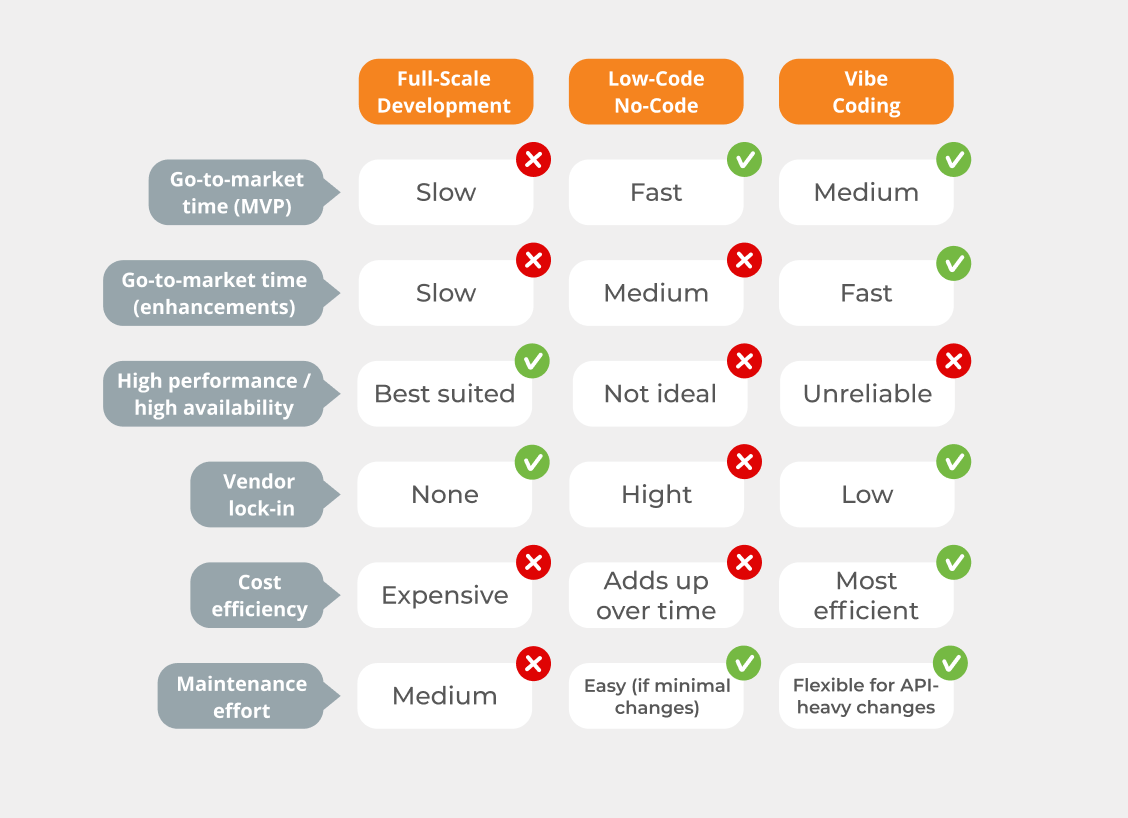Vibe coding is a new way to build software fast — with AI writing and wiring code according to your commands. You sit back, give the AI instructions like “connect my CRM to this mobile operator’s geolocation API,” and let it handle the grunt work.
Sounds dreamy? It can be — but only if done right.
Why MVNOs Need It
MVNOs by definition operate by connecting various systems — like the mobile operator’s radio network and the point-of-sale system of their distributor — which are often beyond their control. The only viable option is to build flexible data flows around those. The reality typically looks like this:
-
- You’re juggling telco APIs, data exports from legacy systems, customer portals, government systems, billing, and more.
- You’re constantly behind in adding the new required workflows, since there are never enough engineers to do the job, and those you have are occupied by fixing the issues in the workflows they developed in the past.
- You’re either paying per-connector / per-call fees on low-code platforms (hello, Boomi) or trying to do ” full-scale” software development and so you are paying per-hour fees to Upwork contractors (or indirectly to your own staff). In either case, the cost is high.
This is where AI-generated code — or “vibe coding” — comes in. Instead of hiring a team to write thousands of lines of code from scratch, a strong developer with AI tools can produce integrations faster and cheaper than no-code/low-code platforms like Make.com.
Sounds too good to be true? The video below is, of course, a joke — but it nails the kind of unrealistic expectations some people have about vibe coding: https://www.youtube.com/watch?v=JeNS1ZNHQs8
The reality is that (as any other technology) it has strong and weak points — and have to know them and adjust your approach.
A Real Recent Project: From Bubble.io to “Vibe-Coded”
We faced some (although not as dramatic as in the video!) vibe-coding issues ourselves. Two years ago, we developed a self-care portal in Bubble.io for customers to manage their PBX configuration. Yes, it was quick to deploy — but then we were struggling with typical issues that plague no-code platforms:
-
- changes to an existing application have to be “clicked through” manually in multiple places since there are few possibilities for reusing the components or even a basic function “search and replace”, available in any source code editor is absent;
- existing logic (when it has conditions and alternative flows) is quite hard to understand;
- sometimes it takes days to troubleshoot a simple issue because your debug capabilities are quite limited; etc.
The final straw? When our reseller wanted to have their own instance of the portal (with minor changes in the branding) we had to upgrade our app to the Team plan, which cost $400 per month – and every time we push the version update to the reseller we still have to tweak many settings manually!
So a decision was made to switch to a “real” code – ReactJS application.
The Truth: It’s Not “Click a Button and You’re Done”
We started by feeding bolt.new our brand-book, back-end API specifications, screenshots of the existing application, and a general description of the tasks. It started working – and voila! – we have something available for preview! Seeing code appear faster than a human could type? Very satisfying. Probably intentional UX psychology. 😉
But pretty UI aside, it had API connection issues that couldn’t be resolved by simply saying, “Fix it!” – it needed help from a real developer familiar with REST.
The problems started when we wanted to add more functionality, for instance, input validation for specific fields or additional data structures to be edited. Despite specific requests – when changing the code to accommodate a new feature “C” it kept accidentally breaking (or removing) existing features “A” or “B”.
Isolating the tasks with git and cursor.ai
We downloaded the source code and added it to a git repository to ensure we have a history of modifications and can clearly see the changes being made. Then we started to progress with implementing missing features with Cursor.ai coding assistant, making sure we provided narrow enough context and restrictions such as “do not introduce new libraries of packages”.
Who did this? A strong junior developer. Not a senior engineer. And he got the job done in 2 days — what would’ve taken a week or more with traditional coding.
So, low-code / no-code is dead?
We recently had another project in Africa: building a mobile app with voice and video calling, back-end APIs of two mobile operators, VoIP softswitch, and a few other pieces. The goal: help the mobile operator with a solution, where instead of losing their revenue for inbound international calls to WhatsApp and others they can actually offer an alternative, get direct access to the customer base outside of the country, and monetize it.
We started prototyping with Boomi (an amazing low-code platform we have been using for years!) but later on moved to regular code + AI. The two main reasons were:
-
- Boomi costs over $100 per connector per month (i.e. a distinctive system we are connecting to), so the total cost would ramp up quickly.
- Using a “pure” cloud version of the low-code engine was not an option because of requirements to connect to the mobile operator’s API via VPN and so on.
So we went with Python/FastAPI code, generated by AI, commanded by a single software engineer.
So, Does It Mean We’ll Switch 100% to Vibe Coding?
Not quite. We’re still maintaining Boomi specialists in our team and continue to use it on other projects where it fits. But it’s essential to recognize the limitations and challenges of each approach.
While vibe coding offers a promising blend of AI assistance and developer control, it’s not without its skeptics. Some view it as an oversimplification of the development process, potentially leading to over-reliance on AI without a deep understanding of the underlying code. That’s a valid concern — which is why human guidance is still critical.
What You’ll Need to Make “Vibe” Coding Work
- Someone who understands software development
Not necessarily a senior dev, but someone who understands components, how they connect, and has some foundation in relevant frameworks (e.g., React, Node.js). Otherwise, they’ll get stuck fast. - Clear integration logic
You still need to know what you’re connecting (APIs, data imports, etc.) and why — and be able to troubleshoot. Garbage in, garbage out. - Basic coding standards
To avoid AI spitting “spaghetti code” (that will drive you and AI crazy in the future) plan ahead – use prompts to structure the code (e.g. to define a re-usable component once and then use it throughout the application). Hint: build a library of those prompts. Just like companies used to have “coding standards”, you need “coding prompting standards” now. Contact me and I’ll share our own set of prompts for building front-end portals. - The right mindset
It’s not a “no effort code.” It’s accelerated code production. Think dev productivity on steroids.
Choose the right tool for the job
There’s no one-size-fits-all when it comes to building software for MVNOs. Each project calls for a different balance of speed, control, and complexity. Here’s how the main options stack up:
-
- Full-scale development gives you total freedom — but comes with a steep cost and long timelines.
- Low-code / no-code is great for simple use cases and quick MVPs — but gets expensive and inflexible fast.
- Vibe coding hits the middle ground: fast like no-code, flexible like real code — if you have a strong dev who knows how to work with AI.

Use above table to figure out which approach fits your next project:
Short go-to-market time with MVP
When you need something to be delivered to the customer yesterday – the low / no-code solutions are the best. Vibe coding will follow with some gap – so perhaps that demo can be rescheduled from tomorrow to next week?
Short go-to-market time with product enhancements
Often people miss the fact that after your data flow is deployed initially – the life doesn’t stop there! The introduction of a new service element, for instance, a DPI platform to differentiate between the types of data traffic of a customer and identifying business customers who are using cheaper residential tariffs, requires changes in your code. And if the changes take time – the cost is not only the implementation time but the missed opportunity cost of not deploying the service quickly enough. Large changes to the existing code are actually the Achilles heel of the no-code/low-code platforms (refer to our example with bubble.io above), so I vote for “vibe coding” as the best option here.
High performance / high availability
For applications where you need to handle a lot of transactions and provide $99.999% uptime of time service (e.g. a component that is involved in processing calls on a mobile network) you need to properly plan the application architecture, test and debug it. Every single code statement counts – so full-scale development obviously is the best choice. With “vibe coding” you will never know whether a generated code is truly optimal – and to fully analyze & optimize it would be a tremendous effort; it’s probably easier to write it from scratch.
Cost
“Vibe coding” is the clear winner here, because you are saving on the cost of a full-scale development team in the near future and you are saving on the accumulated cost of SaaS fees for low-code platform in the long term.
Maintenance efforts
It means how much it will cost you to maintain the software in the future, such as somebody going and fixing an error or making changes to work a new version of MNO’s API. What is the best? It depends — let me explain. In situations when there are only small changes on the technical level, i.e. stay mostly the same, and most of the changes are on the business logic side (for instance you need to send new attributes into your ERP) – go with the low-code. Not only it is easy to do such adjustments, but it can even be done by a person from your team with knowledge of the business area but no real programming skills! On the other hand if we anticipate changes in the components or frequent changes of the API — then Vibe coding is the best.
The bottom line? Use no-code for prototypes, full-scale when stakes are high — but when you need fast, flexible, and budget-conscious development, properly structured vibe coding might be your best bet.
Final Word
Vibe coding is real. For MVNOs, it’s a way to escape platform fees, break out of vendor lock-in, and ship fast. But it’s not automatic. You need a software engineer, a process, and a plan. Done right, it’s cheaper than no-code / low-code approach, faster than classic development — and yours to own.

Guest Blogs are written by carefully selected Experts. If you also want to create a Guest blog then Contact us.
